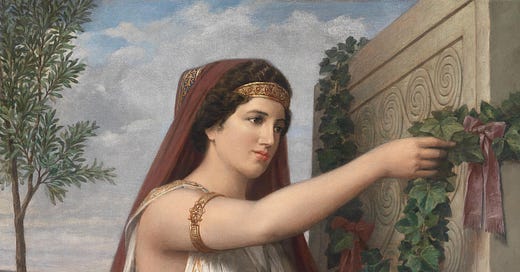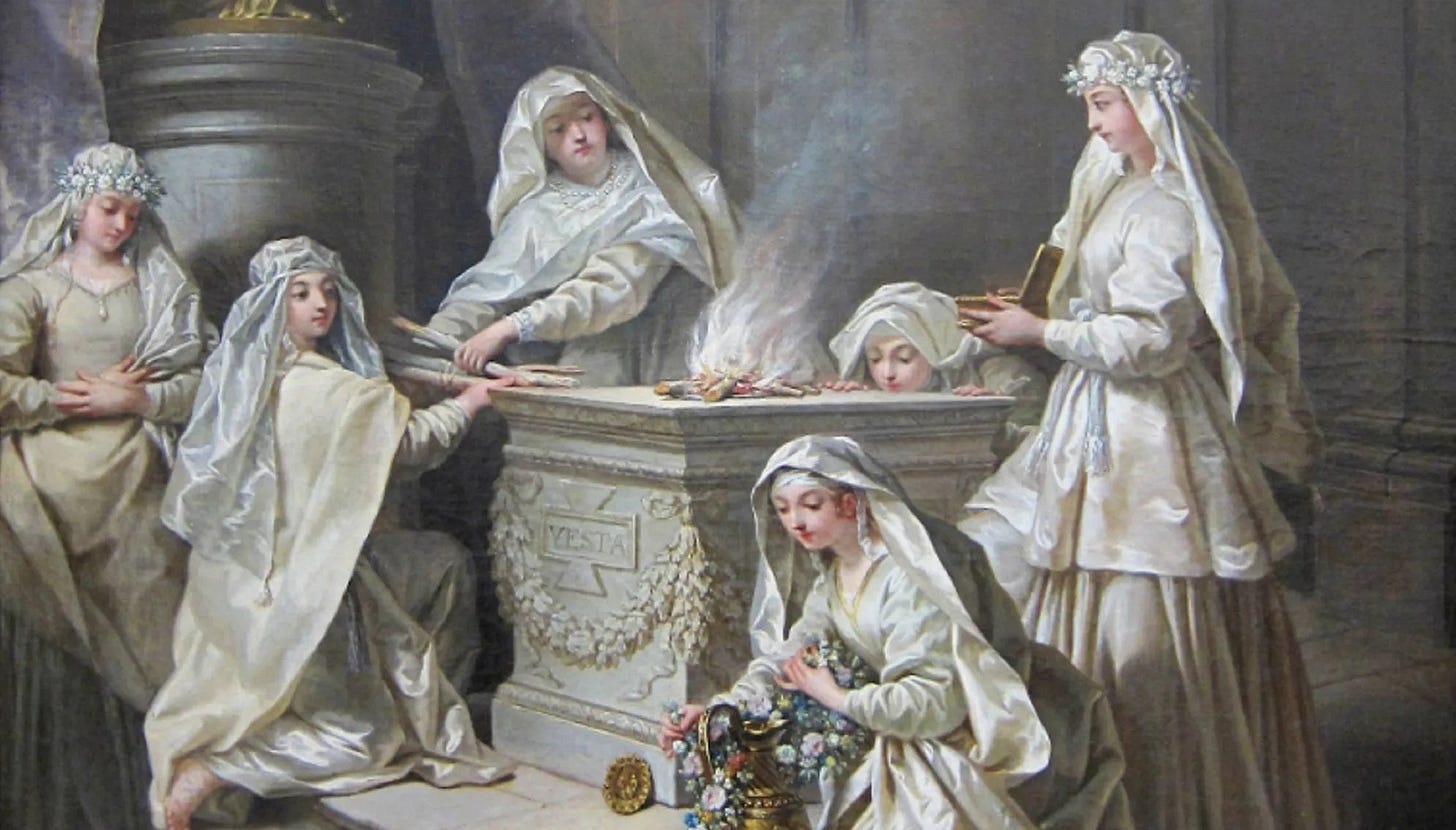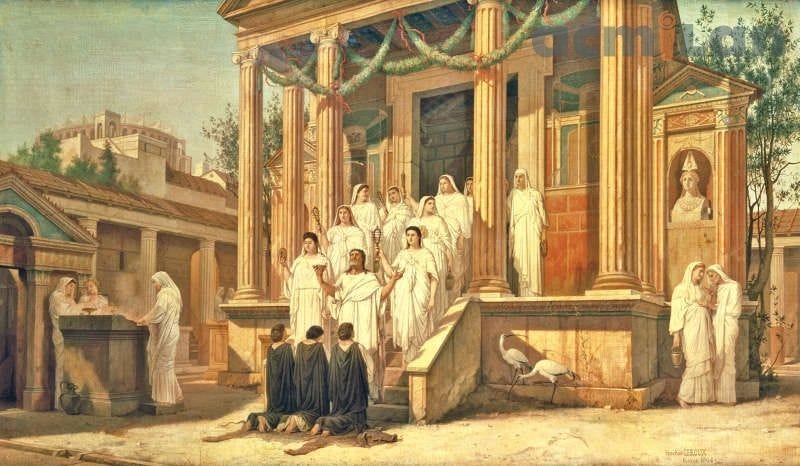In the context of Evolutionary Astrology, Vesta and her Greek counterpart Hestia represent archetypes of inner sanctuary and self-sustenance. These goddesses illuminate the themes of the inner flame, nurturing our inner life force, and the sacred balance between independence and community. They symbolize the necessity of tending to our own inner hearths while simultaneously acknowledging the interconnectedness of our individual sanctuaries with the wider cosmos. Vesta's representation, primarily as a sacred flame rather than a human form, invites us to consider the idea of being “in service” to something greater than ourselves. The Vestal Virgins, as priestesses tasked with maintaining the sacred fire, symbolize the commitment to preserving communal values, traditions, and the sanctity of life.
Inner Sanctuary and the Inner Flame
Vesta embodies the nurturing aspects of the inner sanctuary, representing the space within us where we cultivate our deepest truths and desires. This inner flame is a metaphor for our creative life force, igniting passion, purpose, and authenticity. Just as the sacred fire must be tended to ensure it remains alight, so too must we actively nurture our own inner flames. This nurturing process is not passive; it requires conscious intention and care to maintain our vibrancy and well-being. Hestia, with her association with the hearth, signifies the importance of home, not merely as a physical space but as a psychological one where we find comfort, safety, and belonging. Her presence reminds us that our inner sanctuary serves as a refuge from the chaotic external world. It is in this sacred space that we can connect with our true selves, reflect on our experiences, and foster personal growth. Hestia invites us to honor our need for solitude, to create a sacred pause where we can listen to our inner voice and nurture our spiritual well-being.
Self-Sustaining Life Force
In a world that often emphasizes external validation and societal expectations, Vesta and Hestia teach us the value of self-sustenance. Vesta's embodiment of the independent and self-sufficient woman challenges conventional notions of femininity. In the original context of her myth, the term "virgin" implies a woman who is whole and complete in herself, rather than one bound by societal constructs of chastity. This independence is a vital aspect of our evolutionary journey; it encourages us to cultivate self-reliance and confidence in our abilities to create and sustain our own lives. The sacred fire, central to both Vesta and Hestia’s myths, represents our individual life force that must be tended to regularly. The act of maintaining this flame becomes a ritual of self-care and self-nurturance. When we allow our inner flames to flicker and fade due to neglect, we risk losing touch with our essential selves. Thus, the message is clear: we must prioritize our inner sanctuaries and engage in practices that replenish and empower our spirit.
Nurturing the Inner Life Force
The importance of community and connection is also interwoven into the narratives of Vesta and Hestia. While they emphasize the significance of the inner life, they also remind us that our individual sanctuaries are part of a larger tapestry of existence. Vesta's role as the guardian of the communal hearth reinforces the idea that nurturing our inner flames contributes to the collective well-being. Just as the sacred fire in Vesta’s temple was a focal point for the Roman people, our individual fires can serve as sources of inspiration and connection for those around us. Moreover, the rituals associated with Vesta, such as the offerings made during the Vestalia, highlight the reciprocal nature of sustenance. As we nourish our inner lives, we are called to share the warmth and light of our flames with others, fostering a sense of community and mutual support. The placement of Vesta can indicate how individuals cultivate their inner sanctum, their personal "hearth," while navigating their connections to others. Vesta's emphasis on sustaining the sacred fire can be interpreted as a call to honor one’s inner truth and provide emotional and spiritual nourishment to oneself. This position reflects the necessity of maintaining one's values and ideals, which fosters stability and security both in personal life and broader societal contexts.
Themes of Liminality and Thresholds
Vesta's connection to liminality and thresholds highlights the significance of transitions in our lives, those moments of crossing over from one state of being to another. The limen, or threshold, becomes a sacred space where the old and new coexist, emphasizing the importance of honoring both our roots and our aspirations. This threshold experience aligns with the natural rhythms of life, where loss often paves the way for growth, allowing us to access deeper layers of understanding and spiritual evolution. In the rituals associated with Vesta, the act of keeping the sacred fire alight reflects a commitment to maintaining one's inner light amidst the chaos of external circumstances. The fires in both public and domestic settings serve as reminders that the hearth, whether at home or within the community, requires nurturing and offerings to thrive. The practice of honoring the sacred fire also acknowledges the necessity of tending to our emotional landscapes.
The Phallic Symbolism and Feminine Mysteries
The complexities surrounding the phallic symbolism in Vesta's myths reveal the interconnection between the feminine and masculine energies within the sacred fire. The idea of miraculous impregnation through a phallus emerging from the flames suggests a merging of life forces, emphasizing the unity of creation and destruction inherent in the natural world. This symbolism challenges rigid distinctions between gender, offering a more holistic view of the divine as encompassing both masculine and feminine aspects. This transformative process, framed within the context of feminine mysteries, invites us to embrace the complexities of our existence, fostering a deeper understanding of our interconnectedness and shared experiences.






